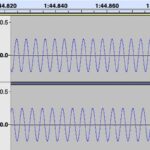There are 5 core types of binaural beats, which will cover in this article.
But just so we're clear before we get into the categories, note that there is only one form of binaural beats. This is an audio phenomenon that occurs naturally in the following way:
When one frequency signal is sent to the left ear through headphones, and one frequency signal is sent to the right ear through headphones, the brain perceives the mathematical difference between the two signals and creates binaural beats.
Audibly, this sounds like a vibrating tone/hum. This tone/hum varies in prominence depending on the frequency.
Binaural beats is a natural science in that the processing happens automatically in the brain.
So if we send a 200 Hz signal to the left ear and a 215 Hz signal to the right ear, the brain will essentially create a third signal that represents the mathematical difference between the two, which in this case is 15 Hz. The brainwaves follow along at this frequency, thus the term brainwave entrainment.
This phenomenon was discovered many years ago, which you can read more about in our free user guide – available here.

So why is this useful?
It's useful because when we are in different states of mind, be that anxious, sleepy, stressed, in pain, or highly productive, focused, energetic, etc., there are certain brainwaves which are dominant over others.
For example, if you can't sleep because your mind is turning over and over with thoughts about a presentation that you have got to give in the morning, you are unable to sleep because your dominant brainwaves are of a high frequency.
High frequency brainwaves are associated with being awake and alert.
So, if we can entrain the brain to specific states at specific times, we can shift the brain into a state more conducive to how we want to feel.
Because the brain / body are programed to respond to routine, to habitual behavior, we can also use brainwave entrainment to create a default response in specific situations.
For example, if a person always gets anxious before social situations, we could use brainwave entrainment before social situations to shift the brain into a state of calm. Doing so regularly will result in a routine response from the brain, whereby the brain associates preparing for a social situation with being calm and moving into a calm state of mind.
So there is a cumulative effect to listening to this type of music.
The 5 Types of Binaural Beats
Please note that the associated states listed under each category do not occur all at once, and do not necessarily occur when listening to a recording within that frequency range.
This is because there are a number of frequencies within a given range, and therefore there are specific frequencies within that range that will cause the brain to respond differently. However, regular entrainment in a particular category will provide an accumulation of benefits.
For example, at the low Alpha range there will be some crossover with the higher end of the Theta range, and the same applies for the other categories.
The following list serves as a rough guide for you to get an idea of each of the types of binaural beats and the associated benefits within each category.
1. Delta: 1-4 Hz
The lowest frequency state is Delta. This state is generally associated with the following:
- Deep sleep
- Pain relief
- Anti-ageing: cortisol reduction/DHEA increase
- Healing
- Access to the unconscious mind
2. Theta 4-8 Hz
Arguably the most popular frequency of brainwave entrainment is Theta binaural beats. Theta is associated with the following:
- Deep relaxation
- Meditation
- Creativity
- hypnopompic & hypnagogic states
3. Alpha 8-14 Hz
Also very popular is Alpha. Alpha is often associated with the state of flow: a zoned in, deeply focused and highly productive state of mind.
- Relaxed focus
- Stress reduction
- Positive thinking
- Accelerated learning
- Effortlessly engaged in activity and environment
4. Beta 14-30 Hz
Beta marks the start of higher frequency brainwave activity and helps with the following:
- Focused attention
- High-level cognition
- Analytical thinking and problem-solving
- Stimulating energy and action
5. Gamma: 30-100 Hz
gamma are even higher frequency waves than beta, and you don't find as many recordings in this range as you would with theta and alpha, particularly in the higher frequency range.
- High level information processing
- Cognitive enhancement
- Memory recall
- Peak awareness
- Transcendental states
Which Type Should You Start With?
It really depends on what you want to achieve. We've written a post that will help you put together your own album, which you can read here.
If you are new to brainwave entrainment and you're unsure where to start, perhaps start with something simple like a Theta recording for relaxation purposes, or an Alpha recording to help you focus at work.
We have split our recordings into categories to make it easy to find what you are looking for:
And also split them down into types of binaural beats:
(Click on a category above and you'll be taken to the relevant page).
General Rules & Advice
Low Vs. High Frequency
We generally advise that our users listen to higher frequency recordings during the daytime and not close to bedtime. This isn't necessarily a problem for everyone, but it isn't wise to stimulate your brain with high-frequency brainwaves before you attempt to sleep.
Similarly, it isn't a good idea to listen to Delta frequency recordings while you are at work, as you may find yourself wanting to fall asleep on the desk!
And in this regard, listening to binaural beats music is actually quite straightforward; because you just plan a listening routine around your day. All our products are clearly titled with the goal, which makes it easy to pick the right recording for the right purpose: e.g. Deep Sleep, Muscle Relaxation, etc.
Listening Duration
We recommend listening to a minimum of 15 minutes of a recording to experienced some benefit. Ideally you would listen for longer than that and the full 30-minute recording provided with your download package. We also provide a 1-hour version of all recordings, and some products have additional versions.
Listening Routine
For new users we recommend starting with 3 recordings a day. You can do more if you feel comfortable doing so, but this is a good starting point, particularly because some people may not be used to wearing headphones for such a long period of time.
After a few days you can change your listening routine, though depending on how much work a particular area requires you may choose to continue with a particular recording daily for one or two weeks, before moving onto something else.
There is more advice on this in our download guide.
Headphones
You can start listening with any pair of headphones, such as those that come free with your phone. However, for an optimal listening experience we recommend closed back headphones, with over ear cups, as opposed to earbud headphones. Higher end Bluetooth headphones will also work just fine.
If you're in the market for new headphones check out this article on best headphones for brainwave entrainment.
Side Effects
There are no known side effects to listening to binaural beats. This is a natural therapy that is completely safe.
The frequencies used in binaural beats music are found in the natural world of sound that we exist in every day, except in this case we are delivering a more concentrated form of specific frequencies to the ears. We have covered this in great detail in this post here.
However, if you suffer from anxiety and want to use binaural beats to help you with this, we advise that you don't listen to Beta or Gamma recordings, as those with anxiety tend to operate on a higher frequency – so to speak – and therefore high-frequency brainwave entrainment may exacerbate this effect and make you feel more anxious.
Stick to the lower frequency entrainment such as Delta, Theta, and Alpha.
Impaired Hearing
We get a number of enquiries asking whether our music is suitable for those with impaired hearing to different degrees. Binaural beats are suitable for those with hearing loss. We have written an extensive post that explains how this works and how you can get the most out of your listening experience. Please find that here.
Scientific Evidence
There are a number of studies that show the efficacy of binaural beats and the potential to help individuals in certain areas of wellbeing. You can find a number of these studies linked from our Benefits page.
We have also written up a number of these studies in greater detail, which can be found here on our blog.
We cover a number of other questions in our FAQ, so please have a look there first if you still have a query, and if not please feel free to drop us an email.
Types of Binaural Beats In Summary
We hope you've found this introduction and links to other resources on our website useful. Here's a quick recap on what we have covered in this post:
- There are five key types of binaural beats: Delta, Theta, Alpha, Beta, Gamma.
- Generally speaking, Delta and Theta are considered low-frequency states, Alpha is somewhat in the middle, and Beta and Gamma are high-frequency states.
- Each covers a specific frequency spectrum, and different associated benefits, and these benefits may overlap between categories.
- Binaural beats can help with numerous areas of wellbeing, including, relaxation/meditation, stress relief, pain relief, focus and productivity, sleep, and more.
- Binauralbeatsmeditation.com is the leading providing of binaural beats music and has thousands of users all over the world, including clinics and therapy groups.










So enjoyed this information. Very helpful, clear and to the point.
If binaural beats produce the difference frequency then why not juts play that frequency?
Greatly appreciated if you could answer this for me.
Bill
There are forms of brainwave entrainment that take that approach, like isochronic tones, which are tones of the same frequency that are separated by short intervals that create a rhythmic pulsing sound.
However, the effectiveness of binaural beats occurs through the perceived tone (beats) existing solely within the auditory system, specifically the part which processes binaural (e.g., stereo) sound. The effect wouldn’t occur in the same way if it was just a single tone of a particular frequency.
I quote:
The binaural beat sensation is often described as being subjectively located “inside” the head and is understood to be modulated at the level of the brainstem in the superior olivary nuclei. (Regan and Regan, 1988; Draganova et al., 2008).
Many thanks for taking the time to explain.
Thanks for this! Question for you – what would be the difference, if any, between creating a Delta (or any state) Binaural beat at 100Hz / 104 Hz and lets say, 520 hz / 524hz? Do the different frequency ranges have any different effects? Or is it all based on the value between the two frequencies, no matter the frequency range (under 1000Hz).
The difference would be the pitch of the tone, so how high or low the tone sounded. But also the effectiveness. We have a guide, which can be loosely followed, known as the Oster Curve, which lays out approximate best practice carrier frequencies for certain tones. Please see here: https://www.binauralbeatsmeditation.com/oster-curve/
I find Binaural beats really helpful.
While doing some research in this interesting subject I cam across this:
:Zen: Chakra Tone and Binaural Beats Generator
https: //ezrecordings.com/kontakt_instruments.php?nik=ni-zen_by_echo_ shore#nik
I have been using this Kontakt Plugin which also feature chakra tones too.
I do wonder if the Carrier Freq plays an important role here too?
Great post.
Hi John, the carrier frequency does play a role in effectiveness. Please see this post: https://www.binauralbeatsmeditation.com/oster-curve/
Hi, thank you for explaining simply. My question is: Does it matter which earbud (right or left) is in which ear? For example, I got some decent tube-style earbuds that I’m happy with, but they don’t say R or L on either earbud, and it’s not on their site. Weird. So, does it matter if I put the left earbud in my right ear & vice versa? If it matters, can you suggest something I can listen to to determine which is which, then I can mark them? Thanks!
Hi, no, it doesn’t matter. As long as you have both earbuds in the effect will work.
great binaural guide, much appreciated
You’re welcome, Darrell.